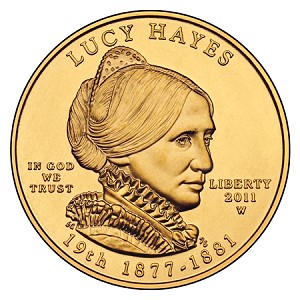by Louis Golino for CoinWeek ……
2012 has been an interesting year for the First Spouse gold $10 coin series.
For the first time in the program’s history the release of the coins has been delayed all year with not a single coin being released so far. That led to all kinds of speculation that the program might be cancelled early, but that was really never in the cards as the coins are required by law unless the law is changed, which has not happened.
U.S. Mint officials recently explained that the delays are a result of striking problems in the production of the coins. They stated that they expect the problems to be resolved, and that the Mint will strike and release all four 2012 issues before year’s end.
According to the Mint, trial strikes were made at the Philadelphia Mint of the first two 2012 spouse coins and problems were discovered in achieving the proper flow of metal when striking the coins. That resulted in problems with the surface quality of the coins.
Last year I noticed some minor issues with the quality of 2011 uncirculated spouse coins when I examined multiple coins at the Mint. Coins from previous years (2007-2010) generally seemed to be of higher quality to me. The 2011 coins also seemed less brilliant or lustrous.
 The Mint did not clarify why the trial strikes for the 2012 coins were done at the Philadelphia facility even though the spouse coins are all minted at West Mint. However, I have heard in the past that trial strikes are normally done at the mint in Philadelphia.
The Mint did not clarify why the trial strikes for the 2012 coins were done at the Philadelphia facility even though the spouse coins are all minted at West Mint. However, I have heard in the past that trial strikes are normally done at the mint in Philadelphia.
The striking problem delay has many collectors concerned because the coins are already expensive to collect, and releasing them in a compressed time frame and at a time of the year when most experts believe gold prices will rise, puts extra pressure on already strained collector budgets.
In addition, many people have questioned the Mint’s rationale for the delay, explaining that there is nothing different about the 2012 designs that would seem likely to result in striking problems. Perhaps the issue lies instead with the machinery the Mint uses to make the coins.
But in any event, it is worth remembering that the 2012 coins will probably be on sale for at least six months, which should give buyers a chance to stagger their purchases and wait for dips in the price of gold.
In the past the coins were generally kept on sale for one year unless sold out before then, but the Mint has ended sales of many coins in the series earlier than many buyers expected in the past couple years. This has really kept first spouse collectors on their toes, trying to figure out when a coin will no longer be available. Typically, the coins go in backorder status before being pulled, but coins can also be put on backorder much earlier in the process, so that is not always a sign of an imminent sell out.
Just because the coins will be released in a short period does not mean collectors have to rush out and get them right after being released. However, a lot of collectors prefer to buy their spouse coins and U.S. Mint collectibles soon after their release because they believe they run the risk of receiving someone else’s returned coins with problems. That probably partly explains why sales of most coin programs are higher in the initial weeks following a coin’s release.
The common perception that gold will rise this fall and in the coming years also helps explain why buyers want to make their purchases sooner rather than later.
The other major development of this series this year is the succession of sell-outs, particularly of the uncirculated coins from 2011, which has resulted in a succession of new series keys and kept collectors guessing about which coins will have the largest aftermarket premiums.
First the Eliza Johnson uncirculated coin sold out and replaced the Julia Tyler BU coin as the new key. Then there was a battle between the Lucretia Garfield and Lucy Hayes coins for series queen.
Because the available sales information from the Mint for the Garfield coin was so much lower than other spouse coins as it approached sell-out, many people rushed out and bought almost 600 of Garfield coins when it went to backorder status, believing the coins would soon sell-out, become the new key, and have a large premium.
But not long after the Mint announced the Garfield coins were no longer available, the Hayes coin sold out and tuned out to have a much lower mintage than the Garfield coin.
The Hayes coin seemed to slip under buyers’ radars as they focused on the Garfield coin.
The Hayes uncirculated coin became the current series key and is garnering nice premiums on the secondary market. Ungraded and MS69 examples are currently bringing about twice issue price, or about $2,000 or more, though few pieces have been sold on e-Bay since the Hayes coin became the new key. I expect those prices to keep rising until or unless the Hayes coin is replaced with another series key.
On August 31 a PCGS MS70 first strike coin, which has a very low population of 160 coins, sold on e-Bay for $4,000, which is a remarkable price for a coin that was available for a quarter of that amount until very recently in raw form.
I do not expect NGC MS70 examples to bring prices as high as that at least initially. But the usual trend of top-graded PCGS modern coins selling for much more than NGC examples in the same grade, especially if first strikes, has begun to change in the past couple years. Over time I have noticed a convergence in PCGS and NGC 70 coin prices, though it clearly varies depending on the coin and its graded population.
The Mint is no longer providing updated figures on sales of the Garfield and Hayes coins because they have been removed from sale. Final mintage numbers could be quite different from currently known information as a result of returns, cancellations, or other adjustments. A final, audited number may not be available for some time.
Collectors who purchase multiples of coins they believe will have large premiums due to low mintages may wish to bear that in mind, and to remember what happened with the Garfield and Hayes coins.
According to the Mint, the last reported sales numbers for the Garfield coin are 2,498 and 2,263 for the Hayes coin. The Hayes number is substantially below any previous keys and unless replaced by another lower mintage coin later, which is entirely possible, the coin should retain a large premium.
On August 28 another BU spouse coin from 2011, the Julia Grant coin, sold out. The last reported sales number for this item is 2,952, which is a low number for the series and in general for a modern coin, but not the lowest for the series so far. It should still be low enough to give the coin a decent premium.
Mint official also announced a change in the maximum mintage levels for the coins in this series. The new limit is 13,000 across both uncirculated and proof options for each release in the series. The previous limit was 15,000 coins.
 Louis Golino is a coin collector and numismatic writer, whose articles on coins have appeared in Coin World, Numismatic News, and a number of different coin web sites. His column for CoinWeek, “The Coin Analyst,” covers U.S. and world coins and precious metals. He collects U.S. and European coins and is a member of the ANA, PCGS, NGC, and CAC. He has also worked for the U.S. Library of Congress and has been a syndicated columnist and news analyst on international affairs for a wide variety of newspapers and web sites.
Louis Golino is a coin collector and numismatic writer, whose articles on coins have appeared in Coin World, Numismatic News, and a number of different coin web sites. His column for CoinWeek, “The Coin Analyst,” covers U.S. and world coins and precious metals. He collects U.S. and European coins and is a member of the ANA, PCGS, NGC, and CAC. He has also worked for the U.S. Library of Congress and has been a syndicated columnist and news analyst on international affairs for a wide variety of newspapers and web sites.





Hi Louis,
Thanks for staying on top of this issue. I regard what’s going on with the First Spouses as the most interesting thing happening at the US Mint since the sale of the San Francisco sets.
Count me in among those skeptical of the Mint’s explanation that they’re suddenly having problems striking the coins. The only thing I can think of is what you mentioned, that the machinery needs to be replaced or overhauled and that the mint is having trouble getting the money needed to do it.
I have started to think that Lucy Hayes may be the key date for longer than people expect for this series. This issue with the first spouses has been attracting a lot of attention and I think it may be starting to create a “pent up demand” situation for the 2012 first spouses, much like what happened when the numismatic gold and silver eagles were cancelled in 2009. On the other hand, the AtBs were also released later than expected and they did not have a sales surge. However, I don’t recall nearly as much collector interest in the AtBs even when they were delayed.
One other point: The Hayes coin, like the previous key, the Julia Tyler coin, is generally perceived as an attractive piece, which should help support its value in the future. Note that even during the brief period when Eliza Johnson was the key, it never acquired the highest premiums in the series probably largely because most people find it unattractive.
Hi Louis,
I tried to post a comment, but it has been “awaiting moderation” all day. Oh well, I guess it wasn’t worth the effort. My bad…
Hi Joe,
Sorry you had trouble. Comments have to be approved by the editor (even from me or other authors), and he was probably just busy today with other things.
I am sure it will be posted soon. Thanks for your patience, and please keep sharing your comments when you have time.
Louis